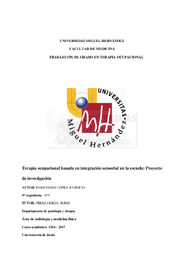Resumen :
En los últimos seis años el número de niños con necesidades educativas especiales ha
aumentado respecto a los años anteriores, esto es debido a la vida sedentaria y la escolarización
temprana de los niños. De los 3 a los 6 años, el niño alcanza su plenitud sensomotora, es el momento
en el que el cerebro está más receptivo a las sensaciones y más capacitado para organizarlas. La
inclusión de la terapia ocupacional con niños en esta etapa podría mejorar su desarrollo y evitará
futuros problemas que puedan repercutir en su rendimiento académico.
El objetivo general es comparar el nivel de desarrollo evolutivo (motor, cognitivo,
comunicativo, social y afectivo) de los alumnos que reciben intervención desde terapia ocupacional
durante un curso académico frente los que no la reciben.
Se realizará un estudio experimental controlado con dos grupos, uno de intervención (n=60) que
recibirá intervención desde terapia ocupacional basada en integración sensorial y otro grupo control
(n=60), que realizará un curso académico normal. Se utilizarán el cuestionario para padres Sensory
Profile, el DeGangi Test, Screening de La Batelle y el Cuestionario Conners a modo de evaluación.
La intervención consistirá en introducir la terapia ocupacional basada en integración sensorial
en una escuela para mejorar el desarrollo de los alumnos de infantil mediante el trabajo del sistema
vestibular, propioceptivo, visual, olfativo, gustativo, táctil y auditivo.
In the last six years, the number of children with special educational needs has increased
compared to previous years, due to the sedentary life and early schooling of children. From 3 to 6
years old, the child reaches its sensory fullness, it is the moment in which the brain is more receptive
to the sensations and more able to organize them. The inclusion of occupational therapy with children
at this stage could improve their development and avoid future problems that may have an impact on
their academic performance.
The general objective is to compare the level of evolutionary development (motor, cognitive,
communicative, social and affective) of the students who receive intervention from occupational
therapy during an academic course in front of those who do not receive it.
A controlled experimental study will be conducted with two groups, one intervention (n = 60),
which will receive intervention from occupational therapy based on sensory integration and another
control group (n = 60), which will perform a normal academic course. Sensory Profile, DeGangi Test,
Screening of La Batelle and Conners Questionnaire will be used as an evaluation.
The intervention will consist of introducing occupational therapy based on sensory integration
in a school to improve the development of children's students through vestibular, proprioceptive,
visual, olfactory, gustatory, tactile and auditory system work.
|
 La licencia se describe como: Atribución-NonComercial-NoDerivada 4.0 Internacional.
La licencia se describe como: Atribución-NonComercial-NoDerivada 4.0 Internacional.
.png)
